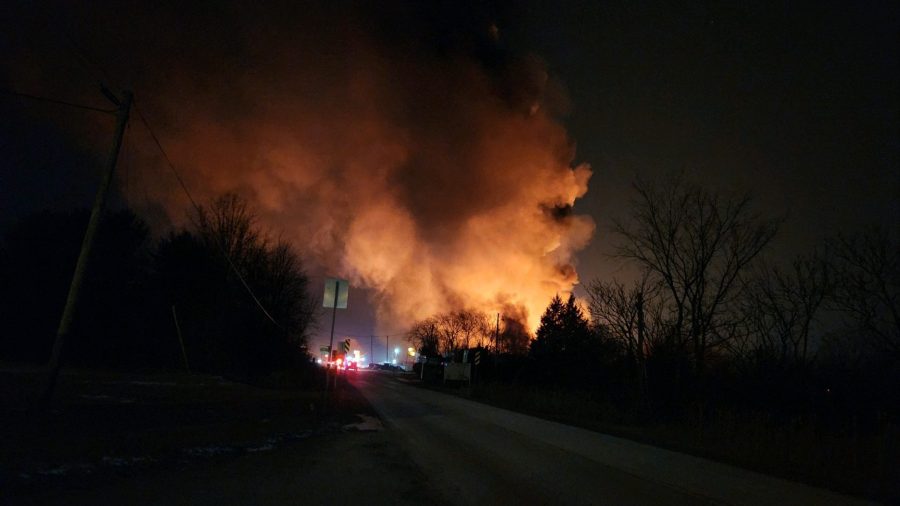Nearby resident says seizures began after Ohio train derailment
- Jon Kent says his life has been turned upside down since the derailment
- The 35-year-old says he started having seizures after the incident
- Experts say it's conceivable the seizures are related to the event
(NewsNation) — Jon Kent was at his home near East Palestine on Feb. 3 when he heard a noise.
“All of a sudden there was a hell of a fire,” he said. “It was much higher than the 100-foot tall trees on the back of my property.”
NewsNation’s Chris Cuomo will host a special edition of “[CUOMO]” Tuesday at 8 p.m. ET, during which he will talk with residents in East Palestine about the aftermath of the derailment, speak to the mayor of the town and delve into the latest testing of soil and water in the area. Not sure how to find NewsNation on your TV? Use our ChannelFinder app.
He went outside to snap photos of what he later learned was the result of a Norfolk Southern train derailment. Kent lived just one mile east of the site on the Pennsylvania side of the border.
Pictures from that day show smoke hovering over his horses. He estimates the emissions were about 10 feet over their heads, so he evacuated them that night.
Three days later, officials conducted an open burn of five tank cars full of vinyl chloride. The toxic smoke blanketed the area.
“We moved maybe 10 miles away, and we were still breathing in the stuff,” he said. “It was like mustard gas or something, for lack of a better description.”

When he eventually returned home, he was met with a terrible smell inside.
“If you had a huge bonfire and just threw nothing but schedule 40 plastic pipe on it for hours, that’s what it smelled like in my house,” he said.
Two weeks after the burn, NewsNation met Jon and his wife Julie at their home. Since then, life has taken a sharp turn.
“On a scale of one to 10, I would say this is a 10 for alteration of my life. This was a curveball I never saw coming,” Jon said.
On the morning of April 21, he fell to the ground. That’s where Julie found him having a seizure.
“I was shaking the furniture and everything,” he said.
Kent said he had never suffered a seizure before then, adding that a CT scan and MRI didn’t turn up anything.
According to Kent, his neurologist told him the derailment may have something to do with it.
“He says that the derailment was a very impactful event in my life and that it perpetuated my grand mal seizures in the sense that I would have likely never had a single seizure event had it not been for these happenings,” Kent said.
Kent’s hospital intake papers say “no history of seizure epilepsy” but do not elaborate on any connection to the derailment.
To date, Jon says he’s had five seizures, the last one in August.
He’s been diagnosed with “partial symptomatic epilepsy” with “complex partial seizures, not intractable, without status epilepticus.”
Now, the 35-year-old arborist and former semi-professional football player looks like a shell of his former self. He can no longer drive or operate machinery.
As for possible causes, the National Institutes of Health (NIH) says there are many and that half of the people living with epilepsy don’t know the cause.
Some cases are genetic, linked to developmental brain abnormalities, while others result from infections, traumatic brain injuries, stroke or brain tumors.
The NIH warns that “anything that disturbs the normal pattern of nerve cell activity — from illness to brain damage to brain development problems — can lead to seizures.”
Potential triggers include “stress” and “exposure to toxins,” the NIH says.
Dr. Beatrice Golomb was appointed by the White House to study the link between toxins and Gulf War veterans’ illnesses.
She said it’s conceivable that the seizures have something to do with the derailment and subsequent burn.
“Multiple rounds of the toxins, even that we know about, have potential to damage what are called mitochondria, which are the energy powerhouses of cells and cause free radical injury. And those mechanisms have again and again been implicated in increasing risk of seizures,” she said.
Kent said he’s worried about his wife if something serious were to happen to him.
“It’s a very scary thing because this has made me think of death in a different way,” he said. “What happens if I am not there to care for [Julie] or for her to depend on?”
He plans to join a class action lawsuit against Norfolk Southern.
While that suit does not assert claims about his, or any other class members’ specific medical condition, it does seek “redress for area residents” who have suffered “loss of use and enjoyment of property, property damage, exposure to toxic material, inconvenience, disruption and economic damages.”
In addition, the lawsuit also seeks a “medical monitoring program” for health issues that may arise from exposure to “toxic substances, toxic fumes and carcinogens.”
We asked Norfolk Southern for an interview with its CEO, Alan Shaw. It did not respond.
Kent wants to make sure the company is aware of the ramifications of its decisions and would like to see Norfolk Southern “do the right thing” moving forward.
“I would also like to be assured that my medical problems are going to be taken care of,” he said. “I can’t make my way through life because of these issues that I’m having.”










